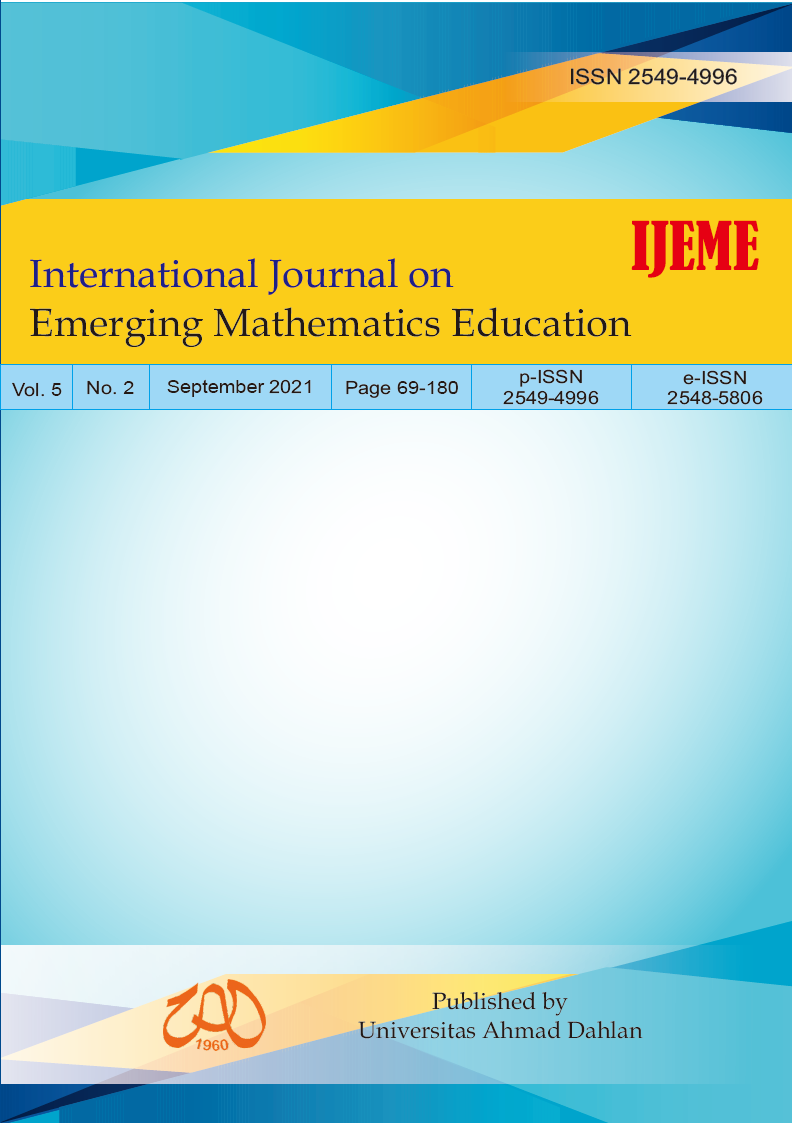Modern Ethnomathematics Mainstreaming through Mathematics Entrepreneurship Using Mathematical Ornaments
DOI:
https://doi.org/10.12928/ijeme.v5i2.15118Keywords:
ethnomathematics, entrepreneurship, parametric equations, spherical coordinates, hypocycloid.Abstract
Modern ethnomathematics is proposed in this article by introducing curves and surfaces to objects based on commonly used mathematics. There are 2 types of objects, batik and ornament. The object is known as Batima, which means a mathematical motif made in a batik stamp. The same design can be used to design ornaments, souvenirs, accessories or other household items such as glasses, t-shirts and other materials. The formation of ethnomathematics is driven by entrepreneurial activities. The method starts with the expansion of the circular and spherical equations based on the variation of the power form which was originally 2 in the equation to be valued at random (say p). The other used equations are parametric equations, especially the hypocycloid which is extended to both curves and surfaces with spherical coordinates. In addition, derivative operators can be applied. Product manufacturing is carried out by at least 10 household businesses around Salatiga and Jogjakarta and its surroundings. In order to sustain the mainstreaming of modern ethnomathematics, entrepreneurial activities are carried out with existing materials through exhibitions and competitions that are followed. Likewise, the use of social media and marketplaces are explored to mainstream the modern ethnomathematics into society.References
Baiduri, B., Ismail, A. D., & Sulfiyah, R. (2020). Understanding the concept of visualization phase student in geometry learning. International Journal of Scientific & Technology Research, 9(2), 2353-2359.
Haara, F. O. (2018). Pedagogical entrepreneurship in school mathematics: an approach for students' development of mathematical literacy. International journal for mathematics teaching and learning, 19(2), 253-268.
Haryanto, N. Toto, Subanji, & Abadyo. (2016). Ethnomathematics in Arfak (West Papua Indonesia): Hidden Mathematics on knot of Rumah Kaki Seribu. Educational Research Review, 11(7), 420–425.
Kang, N. H. (2019). A review of the effect of integrated STEM or STEAM (science, technology, engineering, arts, and mathematics) education in South Korea. Asia-Pacific Science Education, 5(1), 1-22.
Kullberg, A., Runesson Kempe, U., & Marton, F. (2017). What is made possible to learn when using the variation theory of learning in teaching mathematics?. ZDM, 49(4), 559-569.
Mauluah, L., & Marsigit. (2019). Ethnomathematics for elementary student: Exploration the learning resources at kraton Yogyakarta. International Journal of Scientific and Technology Research, 8(7), 776-780.
Olukemi, O. M., & Gbenga, O. E. (2016). Relevance of Mathematics education to entrepreneurship skills acquisition towards the realization of vision 20: 2020. International Journal for Cross-Disciplinary Subjects in Education (IJCDSE), 7(2), 2768-2773.
Palácios, R. F., Montes, L. P., & Paz, D. A. (2019). Mathematical entrepreneurship in educational institutions. Journal of Physics: Conference Series, 1408(1), 012019.
Parhusip, H. A. (2020). Efek Diskritisasi pada Modifikasi Hypocycloid Menjadi CSCPP (Curve Stitching Connected Pseudo Polygon). Jambura Journal of Mathematics, 2(2), 60-72.
Parhusip, H. A. (2018). Algebraic Surfaces for Innovative Education Integrated in Batik Art. Available: https://aip.scitation.org/doi/abs/10.1063/1.5062781.
Parhusip, H. A., Purnomo, H. D., Nugroho, D. B., & Kawuryan, I. S. S. (2021). Learning geometry through surface creation from the hypocycloid curves expansion with derivative operators for ornaments. Desimal: Jurnal Matematika, 4(1), 1-12.
Parhusip, H. A., & Susanto, B. (2018). Inovasi geometri sebagai media pembelajaran matematika kreatif. Kreano, Jurnal Matematika Kreatif-Inovatif, 9(1), 63-70.
Suryaningsih, V., Parhusip, H. A., & Mahatma, T. (2013). Kurva Parametrik dan Transformasinya untuk Pembentukan Motif Dekoratif. Prosiding Seminar Nasional Matematika dan Pendidikan Matematika. Available: http://eprints.uny.ac.id/view/subjects/snmpm2013.html.
Downloads
Published
How to Cite
Issue
Section
License
License and Copyright Agreement
In submitting the manuscript to the journal, the authors certify that:
- They are authorized by their co-authors to enter into these arrangements.
- The work described has not been formally published before, except in the form of an abstract or as part of a published lecture, review, thesis, or overlay journal. Please also carefully read the International Journal on Emerging Mathematics Education (IJEME) Author Guidelines at http://journal.uad.ac.id/index.php/IJEME/about/submissions#authorGuidelines
- That it is not under consideration for publication elsewhere,
- That its publication has been approved by all the author(s) and by the responsible authorities, tacitly or explicitly, of the institutes where the work has been carried out.
- They secure the right to reproduce any material that has already been published or copyrighted elsewhere.
- They agree to the following license and copyright agreement.
Copyright
Authors who publish with the International Journal on Emerging Mathematics Education (IJEME) agree to the following terms:
- Authors retain copyright and grant the journal the right of first publication with the work simultaneously licensed under a Creative Commons Attribution License (CC BY-SA 4.0) that allows others to share the work with an acknowledgment of the work's authorship and initial publication in this journal.
- Authors are able to enter into separate, additional contractual arrangements for the non-exclusive distribution of the journal's published version of the work (e.g., post it to an institutional repository or publish it in a book), with an acknowledgment of its initial publication in this journal.
- Authors are permitted and encouraged to post their work online (e.g., in institutional repositories or on their website) prior to and during the submission process, as it can lead to productive exchanges, as well as earlier and greater citation of published work.
![]()
Ciptaan disebarluaskan di bawah Lisensi Creative Commons Atribusi-BerbagiSerupa 4.0 Internasional.





